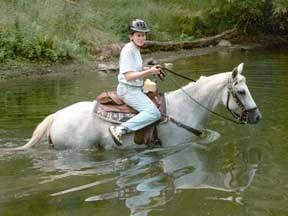 My horse knew the way. I didn’t.
My horse knew the way. I didn’t.
To get back to nature, I’d have to learn -- and trust -- her nature.
Story by Nancy Hoffman; Photos by Phil Hoffman
I couldn’t make out the trail in the dim light. Misty jumped a fallen tree. Then came a gentle turn to the left followed by a sudden rise and drop. A sharp turn was coming up, though I couldn’t see it. Misty ducked a shoulder and we glided around the bend. Then she shied and stopped still. A bow hunter dressed in camouflage stepped from behind a tree.
“For a second there, I thought I had the biggest deer I’d ever seen running right at me,” he said, eyeing my white horse. “I’m glad I didn’t shoot.”
“Me, too,” was the only response I could muster.
My husband, Phil, was riding his horse, Dakota, and I my mare, Misty. We had stayed out too late, riding around the fields near BWI Airport. I hadn’t realized how dark it was until we turned onto the wooded trail for the ride back to the barn. The trail disappeared into a mottle of gray. How could we find our way back?
“Relax,” Phil had told me, “Misty knows the way home.”
Relax, I thought. Easy for him to say. He’d been riding for years; I’d been riding for a few months. Misty had spent those months testing me: trotting off as I climbed into the saddle or, once we were out riding, stopping suddenly, dropping her head and kicking out her hind legs. I was supposed to trust her? I didn’t. I held on for dear life, gripping the horn so tightly blisters formed.
Yet she did know her way, and we made it safely back to the barn. To calm me down, Phil talked about horses. Turns out Misty needs much less light than me to see, and her eyes reflect the light, giving her an even better ability to see at night. During the ride, her ears had swung back and forth, picking up sounds I’d never hear. Maybe it was her strong sense of smell that alerted her to the hunter.
There’s also a theory that horses can sense the ground through their hooves, thus avoiding hidden faults and holes. Finally, Misty had spent her life outside and on the trails; this night was just another day at the office for her.
“Okay, okay,” I said to stop the flow of information. “I’m duly impressed.” But I wasn’t.
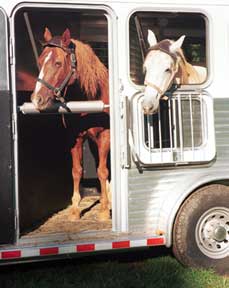 Me? On a Horse? Never!
Me? On a Horse? Never!
Years ago, when Phil was approaching a significant birthday (we don’t need to put a number on it, but trust me, it was big), he stopped to take account of the things he wanted to do but hadn’t gotten around to yet. One of those things was horseback riding. When he quoted Will Rogers, I knew we were in trouble.
I was in the spare bedroom studying when he told me he’d found a horse to buy. “That’s nice, dear,” I said, looking up and smiling at him briefly before returning to my reading. He’d been taking riding lessons, but it was English riding. “Ring riding,” he called it. For Phil, there was only one type of riding: a man and his horse heading out on the trails.
The horse was an eight-year-old ‘appendix’ quarter horse (half thoroughbred, half quarter horse, a common mix for a trail horse) mare. She was white and lightly freckled — flea-bitten it’s called. He named her Misty, for the Johnny Mathis song. It had been his parents’ favorite.
Phil boarded Misty in Severna Park, a few minutes from where we were then living in Arnold. He’d ride her down B&A Boulevard to an open field, where they went around and around and around.
I rarely went with Phil to visit Misty. I was in my second year of law school and had little time for a new hobby. Besides, while Phil had a particular image of riding, I had a most particular image of myself, and it did not include horseback riding. I wanted to pursue a career in public-interest law; I was going to be the righter of wrongs. I was fascinated by ‘the law’ and longed for weekends in the library.
When Phil moved Misty to a larger farm near BWI Airport, he began looking for a second horse. He’d come to love riding so much that he asked me to give it a try. I promised that I would.
Phil found Dakota, a 10-year-old sorrel gelding, also an appendix quarter horse and Misty’s half-brother. But where Misty had been worked only as a trail horse, Dakota had spent years on the rodeo circuit as a barrel racer. Dakota became Phil’s horse. After finishing school, I took to riding Misty. The four of us rode around open fields and trespassed on private property and land owned by the aviation administration, sharing our illicit travels with dirt bikes and ATVs. All the while Misty toyed with throwing me from the saddle. Those early days were a lot of fun.
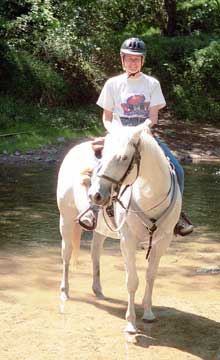 Horse Navigation
Horse Navigation
We were riding in Patapsco Valley State Park, trying to retrace a ride we had taken for the first time the week before. We had followed some friends who knew the route well. I had carefully noted the landmarks and, I thought, memorized the turns. We were trotting along a narrow trail with Phil and Dakota in the lead when they suddenly took a sharp turn onto a trail barely visible through the overgrowth.
Phil hadn’t signaled Dakota to turn; Dakota had taken it on his own. I was restraining myself from asking Phil why he was listening to the horse when Phil called out that Dakota was right. I would have missed the turn; I had to admit that Dakota knew the trails better than me.
We (read Phil) had grown tired of riding around open fields and were seeking more challenging trail riding. Without a horse trailer or even a pickup truck to pull such a trailer, we needed direct access to miles and miles of trails. We first considered moving the horses near the Severn Run Natural Area in Anne Arundel County, but that covered only about 1,400 acres. A friend told us that nothing could beat the trail riding in the Patapsco Valley State Park, which borders Howard and Baltimore counties. The Patapsco Park is comprised of almost 14,000 acres and connects to Liberty Reservoir, another 6,000 acres. We moved the horses to a farm near historic Ellicott City.
We rode directly from the new farm into Patapsco Park and onto its many trails. The only problem was that the trails were unmarked. Phil and I would follow a group from the farm, then try to retrace the ride on our own the next weekend. I’d never had any trouble memorizing things, so I figured learning the trails would be no more difficult than studying for school. But the rides lasted four hours or more. I couldn’t learn all the twists and turns in just one outing.
Phil and I spent a lot of time getting lost, and Misty and Dakota spent a lot of time getting us home. Without fail, Misty and Dakota knew a trail after traveling it only once. In the wild, horses roam great distances to find food and water. Misty and Dakota were calling on that innate ability to observe and learn the terrain.
The long hours on the trails drew me closer to Misty. I began to admire her intelligence, her keen senses and her strength. I was also surprised to find that I enjoyed her quiet company. It was the beginning of our partnership.
Predator and Prey
The trail followed the river’s meandering course. The horses broke into a canter, and the trees and vines rushed by at a pleasant speed. But something traveled with us. I glanced to my right where a great blue heron flew above the river, the heavy beat of its wings answering the clippity clap of the horses’ hooves.
Misty and I have also traveled with deer. They walk along with us in stops and starts as if deciding whether we should be admitted to their group. Other times, the deer move a short distance off the trail, where they stop to watch us pass. Fox have trotted within a few yards of us, and when I stand Misty in the river on a warm day, Canadian geese slowly paddle by.
I am a predator. My eyes are set on the front of my head, and I smell of the meat I occasionally allow myself. Misty is a prey animal. Her eyes are set to the sides of her head, giving her an almost 360-degree field of vision to watch for predators. She smells of the things she eats — grass, leaves, carrots and grain. Misty also pounds at the earth with her hooves when we travel, announcing our presence long before we appear.
When I ride with Misty, deer, fox and geese view me as a prey animal. Perhaps Misty masks my scent or we are so loud that we do not startle them or perhaps they are simply more comfortable with the sound of a hoofed animal as opposed to one wearing hiking boots. Whatever the reason, when I travel with Misty, the wildlife does not fear me and has no reason to flee. Misty has shown me things in the park I would never see without her.
Making, Breaking Bonds
Misty followed me onto the trailer, but only halfway in she stopped. Her eyes grew wide and she threw her head upward, banging it against the roof. Something had frightened her. She backed out, caught her halter on the door jam and pulled it off as her front legs dropped to the ground. Misty was free and scared and wanted to run away.
She ran through the campground, in and out of the trees, acres and acres of parkland calling to her. She would never let me near her now, and I watched her run, paralyzed. A quick-thinking friend took her horse by the lead line and ran her into a nearby corral. Misty followed them. I shut the gate and Misty stood beside her new buddy.
“I just knew she was looking for someone to run away with,” my friend said.
Horses are social animals. Misty and Dakota live in a herd of 16 horses with approximately 200 acres to graze. The herd always stands together in the same general area, and each horse stays especially close to its ‘pasture buddy,’ its best friend. Pasture buddies engage in mutual grooming, stand nose to back end so their twitching tails keep the flies away from their friend’s face and basically hang out together.
Misty’s pasture buddy changes frequently as horses are added to or taken away from the farm. But Dakota has had the same buddy for many years. He is a more-than-30-year-old Appaloosa named Silver. Dakota has been nicknamed ‘Silver’s eyes and ears’ by everyone at the farm. As the name implies, Silver is mostly blind and deaf, so Dakota leads him down to the barn for feedings, keeps him close to the rest of the herd and just seems to take care of him. Sometimes, when Phil takes Dakota from the pasture, Silver will follow his buddy to the gate, repeatedly calling to him. When Phil turns Dakota back out in the pasture, he tells Dakota to go find Silver, who has usually wandered off from the other horses and is standing alone in a corner of the pasture.
Horses live in herds not only for society but also for safety. It’s always good to have many pairs of eyes watching for danger. Then, because they are prey and thus flight animals, as soon as one horse spots danger approaching, they’ll all run away together. When Misty was running free through the campground — though she and my friend’s horse were not boarded at the same farm and were not friendly — it came down to any port in a storm. My friend had used Misty’s basic nature to lead her into the corral and to safety.
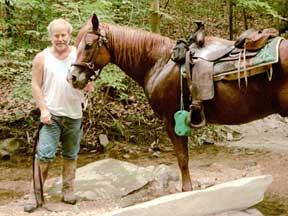 Decision Time: Rider or Horsewoman?
Decision Time: Rider or Horsewoman?
Phil and I walked into the pasture. Dakota came toward Phil and nickered to him. Misty turned her back end to me. When I approached her, she cocked a leg to warn me off. That was the aftermath from Misty’s fright on the trailer. Though she was unhurt (I had attached a bumper hat to her halter so she had not injured her head), she was no longer my horse. I had lost her trust.
Phil and I regularly visit and ride our horses, but there is only so much of a bond we can establish without keeping them at our own place. Most days of the week, someone else cares for them. We had purchased a pickup truck and horse trailer and joined the League of Maryland Horsemen, which owns a campground adjacent to the McKeldin section of Patapsco Valley State Park. We planned on camping with the horses and taking riding vacations. By taking the horses away from the farm and caring for them ourselves, we had hoped to learn more about them and to strengthen the bond. Misty’s fright on the trailer had changed everything. I had to trick her in the pasture to catch her, and she refused to step into the trailer. We weren’t going anywhere.
When Misty was loose and running through the campground, she was in danger of hurting herself and, possibly, someone else. Yet I had been unable to act. I realized then that I was unprepared to care for her. For years I had been only a rider with little appreciation of Misty’s nature and abilities. If I wanted to continue, I would have to learn about her and understand her as I never had before. Misty had taken such good care of me over so many miles and shown me so many things, it was time for me to return the favor.
John Lyons, Pat Parelli, Monty Roberts: you name a horse trainer, I’ve read what they wrote. Picking and choosing from their theories, I gently re-inserted myself into Misty’s society. In the pasture, I looked like a crazy person. I no longer walked in direct lines as a predator does and, instead, tried to imitate the movement of a prey animal. I’d walk toward Misty, then back off, step to the side and stop for a few moments to look around. Some days I would carry the halter but never attempt to slip it over her nose; other days I would put it on in the pasture and take it off a few minutes later. Sometimes I’d take her down from the pasture just to let her eat the clover growing beside our trailer.
I showed up for evening feedings to lead Misty to her stall. I also spent a lot of time brushing her down, trying to mimic the mutual grooming horses engage in along the neck and back. I stopped patting her as I would pat my dogs and started scratching her, another imitation of the grooming she received from the gentle bites of her pasture buddy.
I didn’t ride much, then. Instead, we worked on ground exercises with Misty going through various drills while on a lead or longe (a longer rope) line and not under saddle.
Eventually, I led Misty back to the trailer and asked her to walk into that dark enclosed space, something her instincts tell her never to do. I opened all the doors and windows to let in as much air and light as possible. We started slow, one leg in, then two. She knew what to do, for she was well trained — though not by me. Now I had to find the way to make her feel safe stepping inside the trailer. Then three legs, then four, but she quickly stepped off. Patience, patience, patience.
More months later than I care to admit, Misty began walking onto the trailer without hesitation. I stand beside her and toss the lead line over her back as she takes the first step up. When I am in the pasture, she approaches me and lowers her head as I slide the halter over her nose.
Misty and I have camped at the League of Maryland Horsemen and completed the League’s Four-Day Challenge Ride in which we covered 90 miles. We’ve also spent six days in Virginia riding through the George Washington National Forest. When I travel with Misty, I feed and water her and spend almost every moment of the day beside her. She walks to the fence to greet me and, occasionally, she will nicker to me.
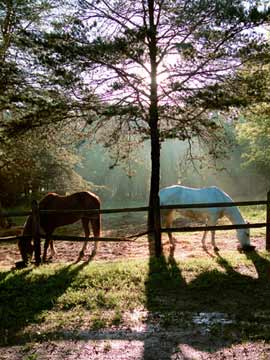 Season’s End
Season’s End
Phil and I stood the horses in the river. Colorful leaves floated by as Misty took a drink. I scratched her neck. Her coat was growing thicker, becoming whiter, the freckles less noticeable. The water was also changing color, turning an uninviting gray.
At the farm, the hay has been cut and baled and sits waiting in the barn to see the horses through the winter. Soon we’ll pull their shoes, giving their hooves a break from the nails that secure the shoe to the hoof. We’ll take the shoes off before the ground freezes. Then, as it hardens, their hooves will toughen. Without shoes, they’ll have better footing in the snow. But there won’t be any riding once the shoes come off. Misty will be fine in the pasture, but she is too tender-footed to ride without shoes. I will visit her, brush her down, remind her of my touch and watch her grow a little wild through the winter.
We climbed out of the river, and the trail was wide with gentle slopes and turns. The four of us ran through the woods, past beaver-scarred trees, the horses working together, pushing and pulling. We began to climb and I rose out of the saddle, taking my weight off Misty’s back. She trotted up the hill, and I knew her step.
Nancy Hoffmann, originally from New York, graduated from the United States Naval Academy. After serving six years on active duty, she attended the University of Maryland School of Law. She works in Annapolis as an attorney. Phil Hoffman is photographer for U.S. Naval Academy athletics and for the Baltimore Ravens.